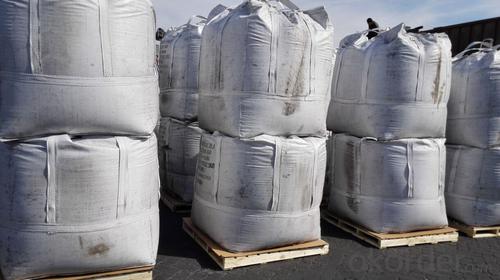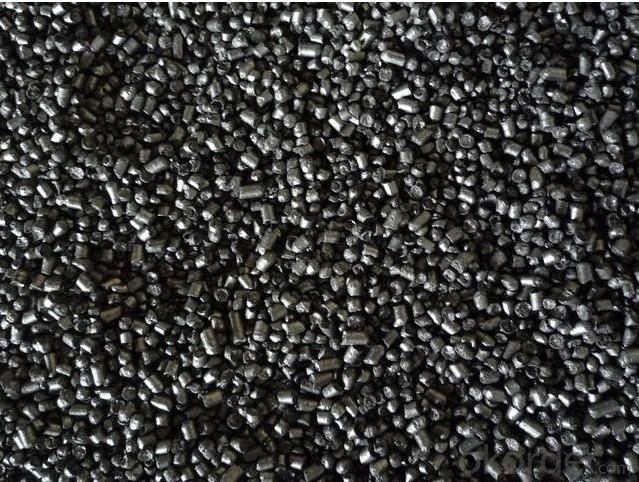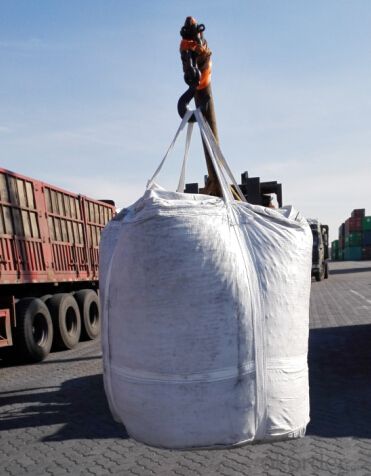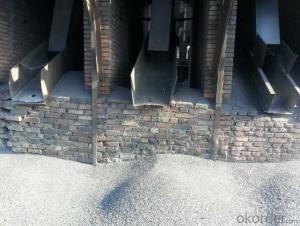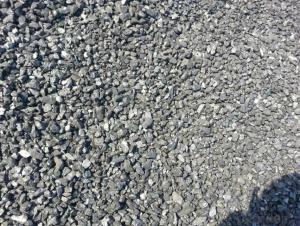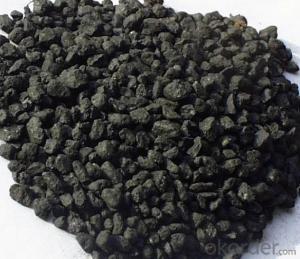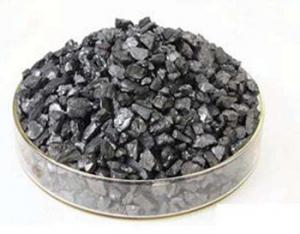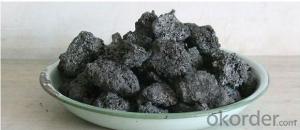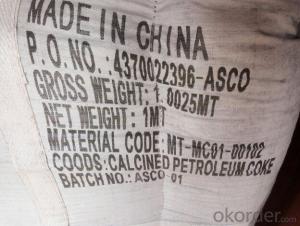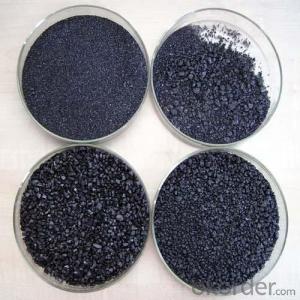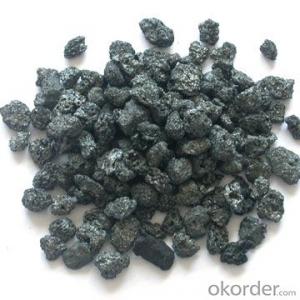Calcined Petroleum Coke FC98% S0.7% Cheap Price
- Loading Port:
- Tianjin
- Payment Terms:
- TT or LC
- Min Order Qty:
- 20 m.t.
- Supply Capability:
- 1500 m.t./month
OKorder Service Pledge
OKorder Financial Service
You Might Also Like
Packaging & Delivery
| Packaging Detail: | 50kg/bag 100kg/bag 1000kg/bag Or according with client need to do |
| Delivery Detail: | 2 weeks |
Specifications
Calcined Petroleum Coke FC98% S0.7% Cheap Price
Petroleum coke products can be divided into needle coke, sponge coke, projectile coke and coke breeze four kinds.
Calcined Petroleum Coke
F.C.: 98.5%MIN
ASH: 0.8% MAX
V.M.: 0.7%MAX
S:0.5%MAX
Moisture: 0.5%MAX
Structure
Calcined Petroleum Coke FC98% S0.7% Cheap Price
Shape: granule
Dimensions: 0-1mm, 1-5mm, 1-6mm, 2-8mm, etc
Product Type: Carbon Additive
C Content (%): 98-99.5% MIN
Working Temperature: -
S Content (%): 0.5%-0.7%MAX
Ash Content (%): 0.7%MAX
Volatile:0.8%MAX
Moisture: 0.5% MAX
ADVANTAGE: low ash & sulfur
COLOR: Black
Feature
Calcined Petroleum Coke FC98% S0.7% Cheap Price
Physics and chemistry performance :
Unit | Index | |||||
No.1 | No.2 | No.3 | ||||
Density | g/cm3 | 2.04 | 2.00 | 2.00 | ||
sulphur content | %≤ | 0.5 | 1.0 | 2.5 | ||
volatility | %≤ | 0.5 | 0.5 | 0.5 | ||
ash content | %≤ | 0.5 | 0.5 | 0.5 | ||
moisture | %≤ | 0.3 | 0.5 | 0.5 | ||
charcoal | %≤ | 98.5 | 98.0 | 98.0 | ||
Image
Calcined Petroleum Coke FC98% S0.7% Cheap Price
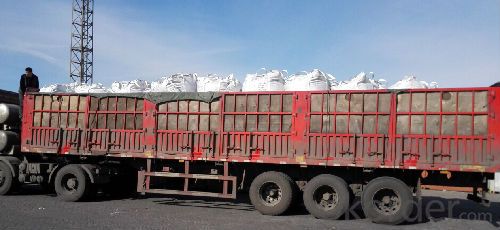
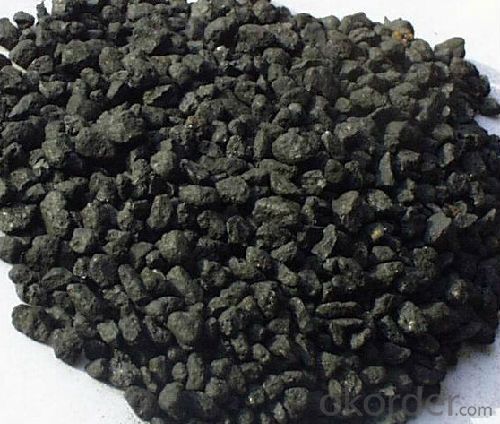
FAQ:
Calcined Petroleum Coke FC98% S0.7% Cheap Price
How to classify calcined petroleum coke?
1) According to difference of sulfur content, can be divided into high sulfur coke (sulfur content more than 4%), sulphur in coke sulfur content (2% 4%) and low sulfur coke (sulfur content below 2%).
2) Petroleum coke products can be divided into needle coke, sponge coke, projectile coke and coke breeze four kinds:
3) Needle coke, has obvious needle-like structure and fiber texture, mainly used for steel-making in high power and ultra-high power graphite electrode. As a result of needle coke in sulfur content, ash content, volatile matter and true density and so on have strict quality requirements, so the production process of needle coke and raw materials have special requirements.
4) The sponge coke, high chemical reactivity, low content of impurities, mainly used in the aluminum industry and carbon industry.
5) Focal or spherical coke: the projectile shape is round, diameter 0.6-30 mm, usually from the production of high sulphur, high asphaltic residual oil, can only be used as industrial fuel power generation, cement etc.
6) Coke breeze: fluidized coking process, the fine particles (0.1- 0.4 mm) in diameter, high volatile, high expansion coefficient, cannot be directly used for electrode preparation and carbon industry.
Advantage:
Calcined Petroleum Coke FC98% S0.7% Cheap Price
1. High quality and competitive price.
2. Timely delivery.
3. If any item you like. Please contact us.
Your sincere inquiries are typically answered within 24 hours.
- Q: I heard that 85 of the furnace rock carbon harmony, and the result that I use advanced strengthening machine when I want to give high-grade furnace rock carbon, this how ah?
- DNF advanced method for obtaining carbon from furnace rock:DNF advanced furnace carbon can acquire rock at the mall, priced at 450 points and 50 points 10 coupon coupon 1.DNF advanced furnace rock carbon action:The use of advanced furnace rock carbon can start at the Kylie advanced equipment reinforcement machine, strengthening the probability of success is greater.Point Keri election advanced strengthening, plus ten or more equipment to strengthen, the probability is 10% more than ordinary furnace carbon
- Q: Can barbecue carbon still have the effect of absorbing formaldehyde?
- 2) activated bamboo charcoal is internationally recognized as a formaldehyde master, active bamboo charcoal masks, gas masks are activated carbon. This product uses the physical function of activated carbon, deodorization, detoxification, without any chemical additives, no impact on the human body, adsorption slow, easy to saturated. There are many kinds of active ingredients, such as coconut shell charcoal, shell charcoal, coal activated carbon and so on.
- Q: What are the limitations of carbon dating?
- Carbon dating, also known as radiocarbon dating, is a widely used method for determining the age of organic materials up to 50,000 years old. While it has revolutionized the field of archaeology and paleontology, it does have certain limitations that researchers must be aware of. One limitation of carbon dating is its inability to accurately date materials beyond the 50,000-year mark. This is due to the fact that carbon-14, the isotope used in carbon dating, has a half-life of only 5,730 years. As a result, after several half-lives, there is not enough carbon-14 remaining in a sample to accurately determine its age. Another limitation is the reliance on organic material. Carbon dating can only be used on organic materials such as bones, shells, wood, and charcoal. This means that it is not applicable to inorganic materials like rocks or minerals. Additionally, the presence of certain contaminants in the sample, such as humic acids or carbonates, can distort the carbon dating results. Furthermore, carbon dating is limited by the fact that it can only provide a relative age for the sample. It determines the ratio of carbon-14 to carbon-12 in the sample and compares it to the known ratio in the atmosphere. By assuming that the ratio has remained constant over time, an estimate of the sample's age can be made. However, variations in the atmospheric carbon-14 levels over time can affect the accuracy of this method. Additionally, carbon dating can be influenced by the presence of nuclear testing and other human activities that have released significant amounts of carbon-14 into the atmosphere. This is known as the "bomb effect" and can result in artificially younger dates for samples collected after the mid-20th century. Lastly, carbon dating can be limited by the size and condition of the sample. In order to obtain accurate results, a sufficient amount of organic material is required for analysis. This can be challenging when dealing with small or degraded samples, as the carbon-14 content may be insufficient or contaminated. In conclusion, while carbon dating is a valuable tool for determining the age of organic materials, it does have certain limitations. Researchers must consider these limitations and be cautious when interpreting the results, taking into account the age range, sample type, presence of contaminants, atmospheric variations, and sample size.
- Q: What is carbon nanotechnology?
- The study and engineering of materials at the nanoscale using carbon-based materials, such as carbon nanotubes and graphene, is known as carbon nanotechnology. This branch of science focuses on manipulating and examining materials at a scale of 1 to 100 nanometers. Carbon nanotechnology takes advantage of carbon's distinctive properties to create and control nanostructures with exceptional mechanical, electrical, and chemical attributes. For instance, carbon nanotubes are cylindrical structures composed of carbon atoms arranged in a hexagonal lattice. Their unique structure grants them remarkable strength, thermal conductivity, and electrical properties. Consequently, carbon nanotubes have a wide range of potential applications in electronics, energy storage, and materials science. They offer the promise of creating stronger and lighter materials, more efficient batteries, and faster and smaller electronic devices. Another carbon-based material, graphene, is a single layer of carbon atoms arranged in a hexagonal lattice. It possesses exceptional strength, electrical conductivity, and thermal conductivity. Graphene has the potential to revolutionize industries such as electronics, medicine, and energy. Its properties make it an ideal candidate for flexible electronics, high-performance batteries, and even drug delivery systems. The development of methods to synthesize and manipulate carbon-based nanostructures is an essential aspect of carbon nanotechnology. Researchers employ techniques like chemical vapor deposition, laser ablation, and molecular self-assembly to create nanoscale carbon materials. These techniques allow for precise control over the size, shape, and properties of the nanostructures, enabling the design of materials with tailored properties for specific applications. In conclusion, carbon nanotechnology explores the unique properties and applications of carbon-based materials at the nanoscale. It has the potential to revolutionize various industries and create new technologies that can bring numerous benefits to society.
- Q: Isotopes of carbon
- There are three kinds of nature of carbon isotope, stable isotopes of 12C, 13C and 14C 14C of the radioactive isotope, the half-life is 5730 years, the application of 14C mainly has two aspects: one is the determination of biological death in archaeology, radioactive dating method; the two is labeled with 14C compound as a tracer, exploration the micro motion of chemistry and life science.
- Q: How does carbon affect the formation of desertification?
- Carbon can indirectly affect the formation of desertification by contributing to climate change. Increased carbon emissions lead to global warming, which alters weather patterns and increases the frequency and intensity of droughts. These prolonged dry periods, combined with other factors such as deforestation and overgrazing, can accelerate soil degradation and ultimately lead to desertification.
- Q: What is the thickness of carbon fiber heating?
- The hair line is 4-5mm, and here is the 2CM thermal insulation board. It's only 2.4,2.5 of the total. You can go to Ji'nan emperor long carbon fiber to see, they have a full product and reliable quality.Please accept the answer and support me.
- Q: How does carbon impact the availability of freshwater resources?
- Carbon can impact the availability of freshwater resources through its role in climate change. Increasing carbon emissions lead to a rise in global temperatures, causing changes in precipitation patterns and melting of glaciers. These changes can result in droughts, reduced snowpack, and altered river flows, ultimately affecting the availability and quality of freshwater resources.
- Q: What's the difference between an alkaline cell and a carbon cell?
- Carbon batteries and alkaline batteries are dry cells, but only in accordance with the quality of different materials and divided into two categories:2. The battery should be full carbon carbon zinc batteries (because it is the general level is the carbon rod electrode is the zinc skin), also known as zinc manganese battery, is currently the most common dry battery, it has the characteristics of low price and safe and reliable use, based on the consideration of environmental factors, because the ingredients still contain cadmium. It must be recovered, so as to avoid damage to the environment of the earth. (so we usually use the carbon rod, the negative electrode is zinc skin, the battery should be recycled)
- Q: The relative molecular mass was between 120-150. The testThe organic matter M, which contains only carbon, hydrogen and oxygen, was measured by mass spectrometer. The relative molecular mass was between 120-150. The mass fraction of oxygen element measured by experiment is 48.48%, the ratio of hydrocarbon to mass is 15:2, and only COOH in M molecule is measured by infrared spectrometer. Then the M formula is?
- The mass fraction of oxygen element is 48.48%, the mass fraction of hydrocarbon is =51.52%, and the mass ratio is 15:2. The mass fraction of carbon is =51.52%x15/ (15+2) =45.46%, and the mass fraction of hydrogen is =51.52%x2/ (15+2) =6.06%The atomic number of C, H and O is higher than that of =45.46%/12:6.06%/1:48.48%/16=3.79:6.06:3.03Molecules contain only COOH, and oxygen atoms must be even numbers.Therefore, the number of atoms in C, H and O can be reduced to =5:8:4, which may be C5H8O4, and the relative molecular weight is 132
Send your message to us
Calcined Petroleum Coke FC98% S0.7% Cheap Price
- Loading Port:
- Tianjin
- Payment Terms:
- TT or LC
- Min Order Qty:
- 20 m.t.
- Supply Capability:
- 1500 m.t./month
OKorder Service Pledge
OKorder Financial Service
Similar products
Hot products
Hot Searches
Related keywords



